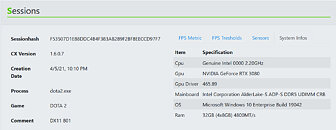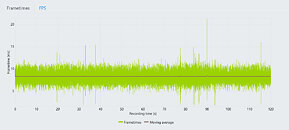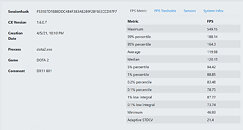Tuesday, May 11th 2021

Intel Alder Lake-S Engineering Sample Spotted with DDR5-4800 Memory Running DOTA 2
Intel's upcoming Alder Lake-S processors are going to be the company's first attempt at delivering heterogeneous core solutions, combining low-power and high-performance IPs in a single chip. Another important milestone that these processors will reach is DDR5 memory adoption, the first of its kind on consumer platforms. Today, thanks to CapFrameX, a monitoring tool that also hosts a database of benchmark runs, we have a piece of recorded information coming from a test system equipped with an Intel Alder Lake-S processor. The tested system spotted an engineering sample of the Alder Lake-S lineup, clocked at just 2.2 GHz. The core count and core configuration remained unknown.
Alongside the upcoming CPU, the system is composed of NVIDIA's GeForce RTX 3080 GPU and DDR5 memory running at 4800 MHz. There were four sticks present, each having 8 GB capacity. The leaked system was running the DOTA 2 game at an average of 119.98 FPS, which doesn't mean much, given that we don't know which settings were applied and what was the resolution. There is a chart showing the gaming frame rate and frame time, which could be interesting to look at. However, the only new information we have come to know is that the Alder Lake-S is already capable of playing games and the ecosystem support should be very good at launch.
Sources:
CapFrameX, via VideoCardz
Alongside the upcoming CPU, the system is composed of NVIDIA's GeForce RTX 3080 GPU and DDR5 memory running at 4800 MHz. There were four sticks present, each having 8 GB capacity. The leaked system was running the DOTA 2 game at an average of 119.98 FPS, which doesn't mean much, given that we don't know which settings were applied and what was the resolution. There is a chart showing the gaming frame rate and frame time, which could be interesting to look at. However, the only new information we have come to know is that the Alder Lake-S is already capable of playing games and the ecosystem support should be very good at launch.



7 Comments on Intel Alder Lake-S Engineering Sample Spotted with DDR5-4800 Memory Running DOTA 2
Too many Watts, too much heat, and barely a change in performance.
Although Cinebench scores show changes in performance, my ancient 4790k’s, 5775C and 8086k show little change outside of extra cores.
Great News
And current processors already do that in a way, in that if you are not doing some demanding job, only some cores will be active and not even run at max frequency, the processor will boost to base core if it needs to and if there is need it will ramp it up to the max boost clock.